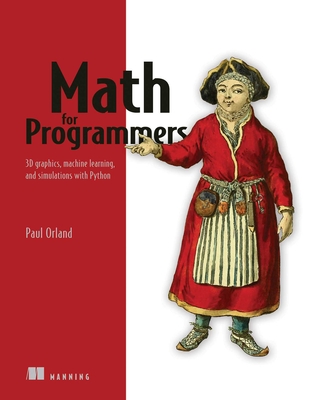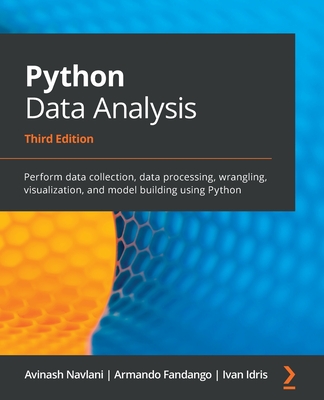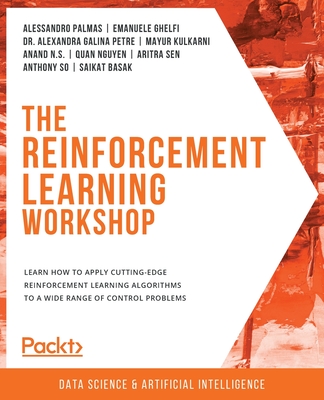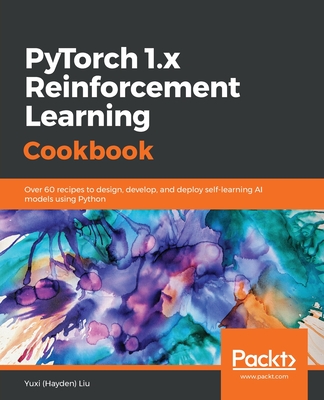Hands-On Reinforcement Learning with R
暫譯: 實作強化學習與 R
Giuseppe Ciaburro
- 出版商: Packt Publishing
- 出版日期: 2019-12-17
- 售價: $1,880
- 貴賓價: 9.5 折 $1,786
- 語言: 英文
- 頁數: 362
- 裝訂: Quality Paper - also called trade paper
- ISBN: 1789616719
- ISBN-13: 9781789616712
-
相關分類:
Reinforcement、DeepLearning
海外代購書籍(需單獨結帳)
買這商品的人也買了...
-
 $1,098Introduction to Computation and Programming Using Python: With Application to Understanding Data, 2/e (Paperback)
$1,098Introduction to Computation and Programming Using Python: With Application to Understanding Data, 2/e (Paperback) -
 $990Hands-On Machine Learning with Scikit-Learn and TensorFlow (Paperback)
$990Hands-On Machine Learning with Scikit-Learn and TensorFlow (Paperback) -
 Data Mining for Business Analytics: Concepts, Techniques, and Applications in R (Hardcover)
Data Mining for Business Analytics: Concepts, Techniques, and Applications in R (Hardcover)$3,950$3,753 -
 $1,188Deep Reinforcement Learning Hands-On
$1,188Deep Reinforcement Learning Hands-On -
 Python 資料分析, 2/e (Python for Data Analysis: Data Wrangling with Pandas, NumPy, and IPython, 2/e)
Python 資料分析, 2/e (Python for Data Analysis: Data Wrangling with Pandas, NumPy, and IPython, 2/e)$880$695 -
 Introduction to Applied Linear Algebra: Vectors, Matrices, and Least Squares (Hardcover)
Introduction to Applied Linear Algebra: Vectors, Matrices, and Least Squares (Hardcover)$1,580$1,548 -
 $1,805Foundations of Deep Reinforcement Learning: Theory and Practice in Python (Paperback)
$1,805Foundations of Deep Reinforcement Learning: Theory and Practice in Python (Paperback) -
 Mathematics for Machine Learning (Paperback)
Mathematics for Machine Learning (Paperback)$1,480$1,450 -
 $2,006Math for Programmers: 3D graphics, machine learning, and simulations with Python (Paperback)
$2,006Math for Programmers: 3D graphics, machine learning, and simulations with Python (Paperback) -
 Python 程式交易應用與實作:從零開始!自動化投資實戰指南
Python 程式交易應用與實作:從零開始!自動化投資實戰指南$500$390 -
 Python Data Analysis : Perform data collection, data processing, wrangling, visualization, and model building using Python, 3/e (Paperback)
Python Data Analysis : Perform data collection, data processing, wrangling, visualization, and model building using Python, 3/e (Paperback)$1,670$1,587 -
 $1,480Interpretable Machine Learning with Python: Learn to build interpretable high-performance models with hands-on real-world examples (Paperback)
$1,480Interpretable Machine Learning with Python: Learn to build interpretable high-performance models with hands-on real-world examples (Paperback) -
 Hands-On Data Analysis with Pandas : A Python data science handbook for data collection, wrangling, analysis, and visualization, 2/e (Paperback)
Hands-On Data Analysis with Pandas : A Python data science handbook for data collection, wrangling, analysis, and visualization, 2/e (Paperback)$1,570$1,492 -
 Data-Driven Science and Engineering: Machine Learning, Dynamical Systems, and Control, 2/e (Hardcover)
Data-Driven Science and Engineering: Machine Learning, Dynamical Systems, and Control, 2/e (Hardcover)$2,275$2,161
商品描述
Key Features
- Explore the design principles of reinforcement learning and deep reinforcement learning models
- Use dynamic programming to solve design issues related to building a self-learning system
- Learn how to systematically implement reinforcement learning algorithms
Book Description
Reinforcement learning (RL) is an integral part of machine learning (ML), and is used to train algorithms. With this book, you'll learn how to implement reinforcement learning with R, exploring practical examples such as using tabular Q-learning to control robots.
You'll begin by learning the basic RL concepts, covering the agent-environment interface, Markov Decision Processes (MDPs), and policy gradient methods. You'll then use R's libraries to develop a model based on Markov chains. You will also learn how to solve a multi-armed bandit problem using various R packages. By applying dynamic programming and Monte Carlo methods, you will also find the best policy to make predictions. As you progress, you'll use Temporal Difference (TD) learning for vehicle routing problem applications. Gradually, you'll apply the concepts you've learned to real-world problems, including fraud detection in finance, and TD learning for planning activities in the healthcare sector. You'll explore deep reinforcement learning using Keras, which uses the power of neural networks to increase RL's potential. Finally, you'll discover the scope of RL and explore the challenges in building and deploying machine learning models.
By the end of this book, you'll be well-versed with RL and have the skills you need to efficiently implement it with R.
What you will learn
- Understand how to use MDP to manage complex scenarios
- Solve classic reinforcement learning problems such as the multi-armed bandit model
- Use dynamic programming for optimal policy searching
- Adopt Monte Carlo methods for prediction
- Apply TD learning to search for the best path
- Use tabular Q-learning to control robots
- Handle environments using the OpenAI library to simulate real-world applications
- Develop deep Q-learning algorithms to improve model performance
Who this book is for
This book is for anyone who wants to learn about reinforcement learning with R from scratch. A solid understanding of R and basic knowledge of machine learning are necessary to grasp the topics covered in the book.
商品描述(中文翻譯)
#### 主要特點
- 探索強化學習和深度強化學習模型的設計原則
- 使用動態規劃解決與建立自學系統相關的設計問題
- 學習如何系統性地實現強化學習算法
#### 書籍描述
強化學習(Reinforcement Learning, RL)是機器學習(Machine Learning, ML)不可或缺的一部分,用於訓練算法。透過本書,您將學習如何使用 R 實現強化學習,探索實際範例,例如使用表格 Q-learning 控制機器人。
您將從學習基本的 RL 概念開始,涵蓋代理-環境介面、馬可夫決策過程(Markov Decision Processes, MDPs)和策略梯度方法。接著,您將使用 R 的函式庫開發基於馬可夫鏈的模型。您還將學習如何使用各種 R 套件解決多臂賭徒問題。透過應用動態規劃和蒙地卡羅方法,您將找到最佳策略以進行預測。隨著進展,您將使用時間差學習(Temporal Difference, TD)來應用於車輛路由問題。逐步地,您將把所學的概念應用於現實世界的問題,包括金融詐騙檢測,以及在醫療保健領域的活動規劃中的 TD 學習。您將探索使用 Keras 的深度強化學習,利用神經網絡的力量來增強 RL 的潛力。最後,您將發現 RL 的範疇並探索構建和部署機器學習模型的挑戰。
在本書結束時,您將對 RL 有深入的了解,並具備有效使用 R 實現 RL 的技能。
#### 您將學到什麼
- 理解如何使用 MDP 管理複雜情境
- 解決經典的強化學習問題,例如多臂賭徒模型
- 使用動態規劃進行最佳策略搜尋
- 採用蒙地卡羅方法進行預測
- 應用 TD 學習尋找最佳路徑
- 使用表格 Q-learning 控制機器人
- 使用 OpenAI 函式庫處理環境以模擬現實應用
- 開發深度 Q-learning 算法以改善模型性能
#### 本書適合誰
本書適合任何想從零開始學習使用 R 進行強化學習的人。對 R 有扎實的理解以及基本的機器學習知識是掌握本書所涵蓋主題的必要條件。
作者簡介
Giuseppe Ciaburro holds a PhD in environmental technical physics, along with two master's degrees. His research was focused on machine learning applications in the study of urban sound environments. He works at the Built Environment Control Laboratory at the Università degli Studi della Campania Luigi Vanvitelli, Italy. He has over 18 years' professional experience in programming (Python, R, and MATLAB), first in the field of combustion, and then in acoustics and noise control. He has several publications to his credit.
作者簡介(中文翻譯)
Giuseppe Ciaburro 擁有環境技術物理學的博士學位,以及兩個碩士學位。他的研究專注於機器學習在城市聲音環境研究中的應用。他在意大利坎帕尼亞大學路易吉·范維泰利的建築環境控制實驗室工作。他在程式設計(Python、R 和 MATLAB)方面擁有超過 18 年的專業經驗,最初專注於燃燒領域,然後轉向聲學和噪音控制。他有多篇出版物。
目錄大綱
Table of Contents
- Overview of Reinforcement Learning with R
- Building Blocks of Reinforcement Learning
- Markov Decision Processes in Action
- Multi-Armed Bandit Models
- Dynamic programming for Optimal Policies
- Monte-Carlo Methods for Prediction
- Temporal Difference Learning
- Reinforcement Learning in Game Applications
- MAB for Financial Engineering
- TD learning in HealthCare
- Exploring Deep Reinforcement Learning methods
- Deep Q learning Using Keras
- Whats Next?
目錄大綱(中文翻譯)
Table of Contents
- Overview of Reinforcement Learning with R
- Building Blocks of Reinforcement Learning
- Markov Decision Processes in Action
- Multi-Armed Bandit Models
- Dynamic programming for Optimal Policies
- Monte-Carlo Methods for Prediction
- Temporal Difference Learning
- Reinforcement Learning in Game Applications
- MAB for Financial Engineering
- TD learning in HealthCare
- Exploring Deep Reinforcement Learning methods
- Deep Q learning Using Keras
- Whats Next?













